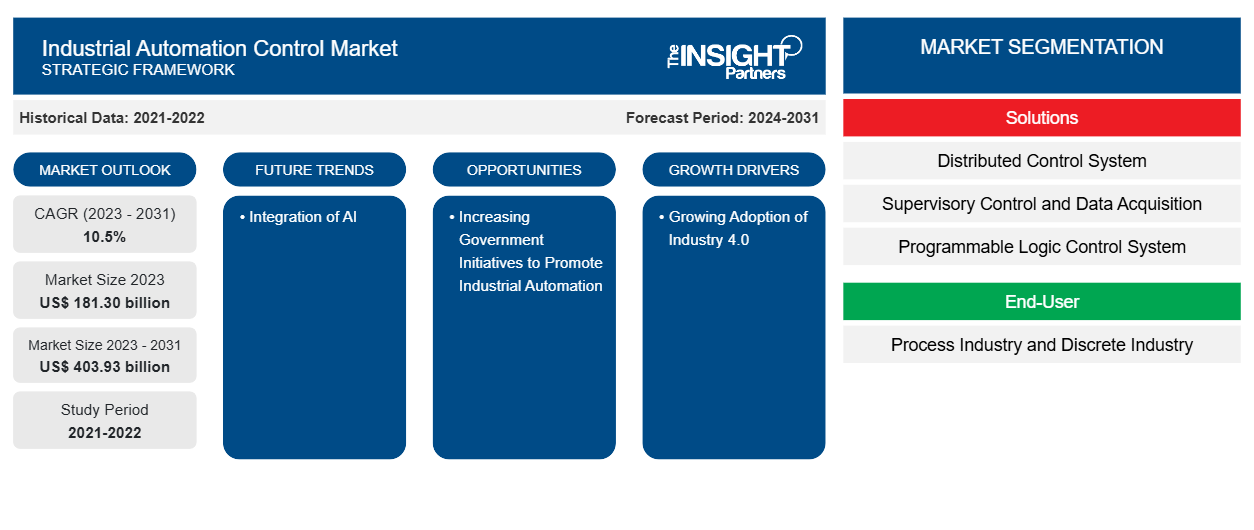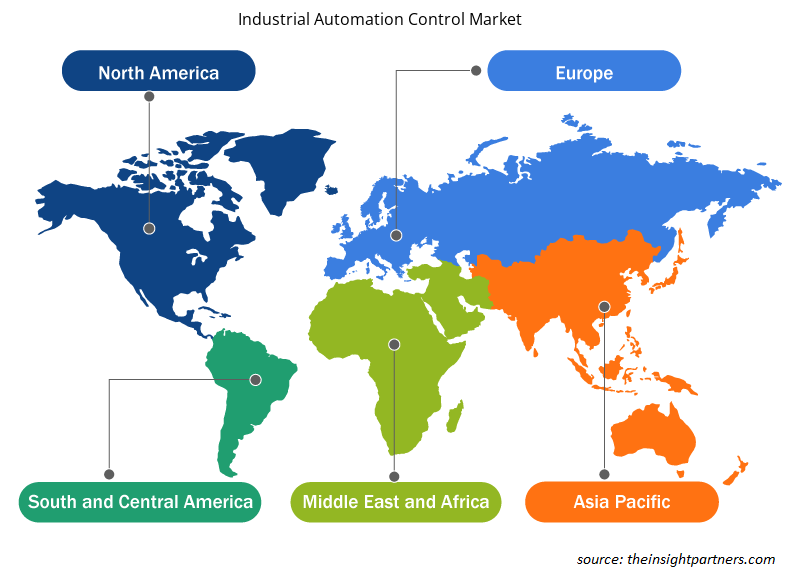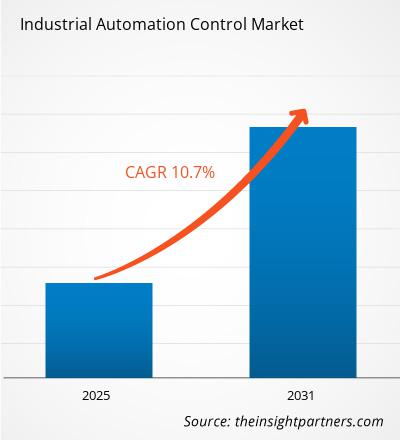산업 자동화 제어 시장 규모는 2024년 1,932억 2천만 달러에서 2031년 3,916억 3천만 달러로 성장할 것으로 예상됩니다. 2025년부터 2031년까지 연평균 성장률(CAGR) 10.7%를 기록할 것으로 예상됩니다. 인공지능(AI)과 머신러닝(ML)의 통합은 향후 몇 년 동안 시장에 새로운 트렌드를 가져올 것으로 예상됩니다.2025년부터 2031년까지 연평균 성장률 10.7%를 기록할 것으로 예상됩니다. 인공지능(AI)과 머신러닝(ML)의 통합은 향후 몇 년 동안 시장에 새로운 트렌드를 가져올 것으로 예상됩니다.
산업 자동화 제어 시장 분석
제조업 자동화는 조립 라인 및 포장 공정 제어부터 정밀 가공이나 화학 생산과 같은 복잡한 작업 감독에 이르기까지 다양한 분야에 걸쳐 활용됩니다. 실시간 데이터 수집 및 분석을 통해 자동화 시스템은 결함을 감지하고, 유지보수 필요성을 예측하며, 워크플로를 최적화하여 고장 및 다운타임을 줄일 수 있습니다. 이를 통해 시장 변화나 소비자 수요에 신속하게 대응할 수 있는 더욱 민첩한 생산 환경을 구축할 수 있습니다. 산업 자동화 제어는 인적 오류를 줄이고 운영 감독을 강화함으로써 작업장 안전 개선에도 중요한 역할을 합니다. 기업의 경우, 상당한 비용 절감, 생산 주기 단축, 그리고 운영을 더욱 효과적으로 확장할 수 있는 역량 확보로 이어질 수 있습니다. 산업계가 자동화 기술을 지속적으로 도입함에 따라, 더욱 높은 수준의 경쟁력과 혁신을 달성하고, 점점 더 디지털화되고 세계화되는 시장에서 장기적인 성장과 성공을 위한 입지를 다질 수 있습니다.
산업 자동화 제어 시장 개요
산업 자동화 제어는 컴퓨터, 로봇, 정보 시스템 등 첨단 기술과 제어 시스템을 활용하여 산업 공정 및 장비를 관리하고 모니터링하는 것을 의미합니다. 산업 자동화 제어의 목표는 제조 과정에서 사람의 개입을 줄임으로써 효율성, 생산성, 그리고 안전성을 향상시키는 것입니다. 기업에서 산업 자동화 제어는 반복적이고 시간 소모적인 작업을 자동화하여 생산 효율을 높이고, 더 빠르고 정확하며 일관된 결과물을 제공합니다. 자동화를 통해 기업은 운영 효율성을 높이고, 오류 위험을 줄이며, 인건비를 최소화하는 동시에 높은 수준의 제품 품질을 유지할 수 있습니다. 이러한 시스템은 센서, 로봇, 인공지능(AI)을 통합하여 생산 라인을 실시간으로 모니터링하고 제어하며, 성능 향상 및 낭비 감소를 위한 조정을 수행합니다.
귀하의 요구 사항에 맞게 이 보고서를 사용자 정의하세요
이 보고서의 일부 또는 국가 수준 분석, Excel 데이터 팩을 포함하여 모든 보고서에 대한 사용자 정의를 무료로 받을 수 있으며, 신생 기업 및 대학을 위한 훌륭한 혜택과 할인도 이용할 수 있습니다.
산업 자동화 제어 시장: 전략적 통찰력

-
이 보고서에서 주요 시장 동향을 알아보세요.이 무료 샘플에는 시장 동향부터 추정치 및 예측까지 다양한 데이터 분석이 포함됩니다.
산업 자동화 제어 시장 동인 및 기회
다양한 산업 분야에서 산업 자동화 제어의 광범위한 채택
자동차 산업을 제외한 다른 산업에서도 산업 자동화 제어의 도입이 빠르게 확대되고 있습니다. 최근까지 비자동차 산업은 자동차 산업에 비해 도입률이 매우 낮았습니다 . 산업용 로봇 과 같은 장비의 기능이 향상됨에 따라 , 비자동차 산업에서도 산업 자동화 제어 도입이 더욱 가속화될 것으로 예상됩니다.
산업 분야 외에도 국가별로 보급률이 증가하고 있습니다. 중국, 미국, 일본을 포함한 선진국 시장의 보급률이 더 높지만, 선진국 시장에서도 산업 시장이 더욱 성장할 수 있는 많은 기회가 있습니다. 예를 들어, 2023년 중국은 총 생산량의 35%를 차지했는데, 이는 미국의 총 생산량의 거의 세 배에 달하는 수치이며, 12%로 2위를 차지했습니다. 이러한 국가들 중 다수, 특히 자동차 산업을 제외한 많은 국가에서 추가 설비 설치 전망이 매우 밝습니다. 이러한 성장은 해당 시장에 필요한 현대화와 혁신에 기인합니다. 이러한 통계는 제조업체들에게 긍정적인 신호이며, 도입률이 더욱 증가할 가능성이 크다는 것을 의미합니다.
정부 지원 증가
전 세계 산업계가 효율성 향상과 제조 공정 간소화를 위해 노력함에 따라, 산업 자동화 제어를 촉진하는 데 있어 정부와 정책 입안자의 중요성이 크게 높아졌습니다. 산업 자동화 제어가 제4차 산업혁명 추진에 중추적인 역할을 함에 따라, 정부와 정책 입안자는 산업 자동화 제어의 광범위한 도입과 성장을 촉진하기 위한 적절한 지원 메커니즘과 규제 체계를 구축해야 합니다. 예를 들어, 인도 정부는 스마트 제조 부문 강화를 위해 여러 조치를 시행했으며, 그 핵심 사업 중 하나가 생산 연계 인센티브(PLI) 제도입니다. 2020년에 시작된 PLI 제도는 자동차, 제약, 섬유, 식품 가공, 백색 가전 등 14개 산업을 대상으로 하며, 국내 제조 활성화를 위한 광범위한 전략의 일환입니다. 이 제도는 국내에서 제품을 생산하고 특정 투자, 판매 및 수출 기준을 충족하는 기업에 재정적 인센티브를 제공함으로써 기업들이 스마트 제조 관행을 도입하도록 장려하기 위해 고안되었습니다. 이 이니셔티브는 이러한 기업의 경쟁력을 강화하고 궁극적으로 인도 제조 부문의 전반적인 가치를 높이는 것을 목표로 합니다.PLI) scheme. Launched in 2020, the PLI scheme targets 14 sectors, including automobiles, pharmaceuticals, textiles, food processing, and white goods, as part of a broader strategy to promote domestic manufacturing. The scheme is designed to encourage companies to adopt smart manufacturing practices by offering financial incentives to those that produce goods locally and meet specific investment, sales, and export criteria. This initiative aims to enhance the competitiveness of these companies and, in turn, elevate the overall value of India's manufacturing sector.
마찬가지로 미국에서는 2023년 에너지부(DoE)가 중소 규모 시설의 스마트 제조 도입을 촉진하기 위한 12개 주 정부 프로그램을 지원하기 위해 2,200만 달러 규모의 이니셔티브를 발표했습니다. 대통령의 초당적 인프라법에 따라 자금이 지원되는 이 이니셔티브는 미국 제조업 부문에서 스마트 제조 기술과 고성능 컴퓨팅에 대한 접근성을 향상하는 것을 목표로 합니다. 또한, 2023년 8월, 제조용 첨단 로봇 연구소(ARM)는 8개의 새로운 단기 사이클 기술 프로젝트를 최종 후보로 선정하고 23-01 기술 프로젝트 공모를 통해 총 약 326만 달러의 자금을 지원할 계획입니다. 이러한 이니셔티브는 스마트 제조 부문을 활성화하고 산업 자동화 제어 시장 성장을 촉진할 수 있는 중요한 기회를 제공할 것으로 예상됩니다 .
산업 자동화 제어 시장 보고서 세분화 분석
산업 자동화 제어 시장 분석에 기여한 주요 부문은 시스템과 최종 사용자입니다.
- 산업 자동화 제어 시장은 시스템 기준으로 SCADA, DCS, PLC, PLM 등으로 세분화됩니다. SCADA 부문은 2024년에 시장을 주도했습니다.
- 산업 자동화 제어 시장은 최종 사용자 기준으로 공정 산업과 개별 산업으로 구분됩니다. 개별 산업 부문은 2024년에 시장을 주도했습니다.
지역별 산업 자동화 제어 시장 점유율 분석
산업 자동화 제어 시장은 북미, 유럽, 아시아 태평양, 중동 및 아프리카(MEA), 남미 등 5개 주요 지역으로 구분됩니다. 2024년에는 북미 지역이 시장을 주도했습니다.
북미 전역에서 기술 발전은 경쟁이 치열한 시장을 조성하여 혁신과 경제력의 중심지로 자리매김했습니다. 이 지역 기업들은 고품질 제품과 서비스에 대한 증가하는 수요를 가장 효율적인 방식으로 충족하기 위해 끊임없이 비즈니스 프로세스를 최적화하고 있습니다.
글로벌 기업들은 산업 자동화 제어 시장의 성장을 촉진하기 위해 다양한 이니셔티브를 실행하고 있습니다. 예를 들어, 2024년 12월, ONDEX Automation(이하 "ONDEX" 또는 "회사")은 뉴저지주 무어스타운에 본사를 둔 제어 시스템 및 산업 자동화 서비스 분야의 선도 기업인 Automation & Control Inc.(이하 "ACI")와의 파트너십을 완료했다고 발표했습니다. 이 전략적 파트너십은 북미 제조 고객에게 혁신적인 자동화 솔루션을 제공한다는 ONDEX Automation의 사명에 있어 중요한 이정표입니다. 시카고에 본사를 둔 사모펀드 회사인 Shore Capital Partners의 지원을 받는 ONDEX Automation은 북미 제조 고객의 요구를 충족하는 선도적인 시스템 통합업체를 구축하고 있습니다. ONDEX는 다양한 역량, 숙련된 엔지니어링 인재, 그리고 혁신과 우수성에 대한 공동의 의지를 갖춘 공장 자동화 시스템 통합업체와의 파트너십을 위한 추가 기회를 적극적으로 모색하고 있습니다. 북미 산업 자동화 제어 시장의 주요 기업으로는 Rockwell Automation Inc., ABB Ltd., Mitsubishi Electric Corporation 등이 있습니다. 이 기업들은 혁신을 주도하고 이 지역 산업 자동화의 미래를 만들어가고 있습니다.
산업 자동화 제어 시장 지역별 통찰력
Insight Partners의 분석가들은 예측 기간 동안 산업 자동화 제어 시장에 영향을 미치는 지역별 동향과 요인을 면밀히 분석했습니다. 이 섹션에서는 북미, 유럽, 아시아 태평양, 중동 및 아프리카, 중남미 지역의 산업 자동화 제어 시장 부문 및 지역별 현황도 살펴봅니다.

- 산업 자동화 제어 시장에 대한 지역별 데이터를 얻으세요
산업 자동화 제어 시장 보고서 범위
| 보고서 속성 | 세부 |
|---|---|
| 2024년 시장 규모 | 1,932억 2천만 달러 |
| 2031년까지 시장 규모 | 3,916억 3천만 달러 |
| 글로벌 CAGR(2025~2031년) | 10.7% |
| 역사적 데이터 | 2021-2023 |
| 예측 기간 | 2025-2031 |
| 다루는 세그먼트 |
시스템별
|
| 포함된 지역 및 국가 |
북아메리카
|
| 시장 선도 기업 및 주요 회사 프로필 |
|
산업 자동화 제어 시장 참여자 밀도: 비즈니스 역학에 미치는 영향 이해
산업 자동화 제어 시장은 소비자 선호도 변화, 기술 발전, 그리고 제품 이점에 대한 인식 제고 등의 요인으로 인한 최종 사용자 수요 증가에 힘입어 빠르게 성장하고 있습니다. 수요가 증가함에 따라 기업들은 제품 및 서비스 확장, 소비자 니즈 충족을 위한 혁신, 그리고 새로운 트렌드를 적극 활용하고 있으며, 이는 시장 성장을 더욱 가속화하고 있습니다.
시장 참여자 밀도는 특정 시장이나 산업 내에서 활동하는 기업들의 분포를 나타냅니다. 이는 특정 시장 공간에 얼마나 많은 경쟁자(시장 참여자)가 존재하는지를 규모나 전체 시장 가치 대비로 나타냅니다.
산업 자동화 제어 시장에서 운영되는 주요 회사는 다음과 같습니다.
- ABB 유한회사
- 허니웰 인터내셔널 주식회사
- 지멘스 AG
- 에머슨 일렉트릭 주식회사
- 보쉬 렉스로스 AG
- 제너럴 일렉트릭 회사
면책 조항 : 위에 나열된 회사는 특정 순서에 따라 순위가 매겨지지 않았습니다.

- 산업 자동화 제어 시장의 주요 기업 개요를 알아보세요
산업 자동화 제어 시장 뉴스 및 최근 동향
산업 자동화 제어 시장은 1차 및 2차 조사 이후 주요 기업 간행물, 협회 자료, 데이터베이스 등 정성적 및 정량적 데이터를 수집하여 평가합니다. 산업 자동화 제어 시장의 몇 가지 동향은 다음과 같습니다.
- 보쉬렉스로스는 두 가지 새로운 솔루션을 통해 자동화 분야에서 BODAS 생태계를 확장하고 있습니다. 충돌 방지 시스템은 레이더, 초음파, 스마트 카메라를 사용하여 정확한 물체 감지 및 사람 감지를 통해 충돌을 효과적으로 방지합니다.
(출처: 보쉬렉스로스, 보도자료, 2025)
- ABB는 기존 공정 제어 시스템 설비를 현대화하는 데 필요한 하드웨어 제품 포트폴리오인 ABB Ability Symphony Plus SDe 시리즈를 출시했습니다. 이 시리즈는 플랜트 운영에 대한 위험과 중단을 최소화하면서 기존 공정 제어 시스템 설비를 현대화하는 데 도움을 줍니다. 이 새로운 시리즈는 전력, 수도, 석유 및 가스, 제약, 펄프 및 제지 등의 산업 분야 플랜트 운영자들이 설치된 제어 시스템을 최신 기술로 업그레이드하여 효율성과 생산성 향상을 도모할 수 있도록 지원합니다.
(출처: ABB, 보도자료, 2024)
산업 자동화 제어 시장 보고서 범위 및 제공 내용
"산업 자동화 제어 시장 규모 및 예측(2021~2031)"은 아래 언급된 분야를 포괄하는 시장에 대한 자세한 분석을 제공합니다.
- 범위에 포함된 모든 주요 시장 부문에 대한 글로벌, 지역 및 국가 수준의 산업 자동화 제어 시장 규모 및 예측
- 산업 자동화 제어 시장 동향 및 동인, 제약 및 주요 기회와 같은 시장 역학
- 자세한 PEST 및 SWOT 분석
- 주요 시장 동향, 글로벌 및 지역 프레임워크, 주요 참여자, 규정 및 최근 시장 개발을 포괄하는 산업 자동화 제어 시장 분석
- 시장 집중도, 히트맵 분석, 주요 업체 및 산업 자동화 제어 시장의 최근 개발 사항을 다루는 산업 환경 및 경쟁 분석
- 자세한 회사 프로필
- 과거 분석(2년), 기준 연도, CAGR을 포함한 예측(7년)
- PEST 및 SWOT 분석
- 시장 규모 가치/거래량 - 글로벌, 지역, 국가
- 산업 및 경쟁 환경
- Excel 데이터세트
최근 보고서
사용 후기
구매 이유
- 정보에 기반한 의사 결정
- 시장 역학 이해
- 경쟁 분석
- 고객 인사이트
- 시장 예측
- 위험 완화
- 전략 기획
- 투자 타당성 분석
- 신흥 시장 파악
- 마케팅 전략 강화
- 운영 효율성 향상
- 규제 동향에 발맞춰 대응






















 무료 샘플 받기 - 산업 자동화 제어 시장
무료 샘플 받기 - 산업 자동화 제어 시장